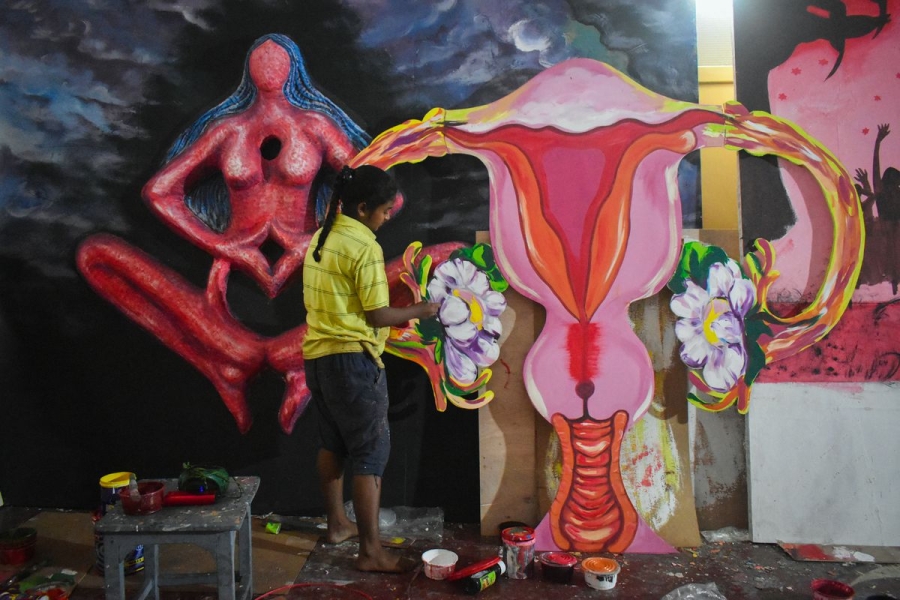From wound healing to disease diagnosis, “this stuff is like gold dust.”

Byrd Pinkerton is a senior producer and reporter on Unexplainable, Vox’s science podcast. She covers everything scientists don’t yet know but are trying to figure out, so her work explores everything from the inner workings of the human body to the distant edges of the universe.
Leah Hazard grew up in America in the 1980s and ’90s, and, as she remembers it, it was not a great time to be a menstruating person.
“Back then it was very much just periods are gross,” she says, “I mean, not even to be spoken of — and when you have a period, the stuff that comes out is disgusting, and it’s smelly, and it’s shameful and dirty, and you should just flush it away.”
This isn’t particularly surprising. As recently as 2010, Seventeen Magazine was running “embarrassing” period stories about the horrors of having your boyfriend reach into your coat pocket and pull out a tampon.
What’s maybe more surprising, though, is that this aversion to menstruation hasn’t been limited to teen magazines and school corridors. It’s also found in the scientific literature — or the lack thereof. One set of researchers found that some 15,000 papers about semen were published in the 2010s … compared to around 400 about menstrual fluid.
But, as Hazard, a midwife and author, documents in her book, Womb, that’s starting to change. Scientists from around the world are starting to study menstrual blood — or menstrual “effluent,” as Hazard calls it, because it is not just blood but a mix of fluids, cells, proteins, and more. And as researchers look into this effluent, they’re finding that it is not only not trash, but potentially treasure.
“This stuff is like gold dust,” Hazard says.
For the next two weeks, we’ll be digging into the potential treasures hidden away in menstrual fluid on Unexplainable, Vox’s science podcast. But I also spoke to Hazard about her book and the many exciting possibilities for menstrual effluent she discovered while reporting it. What follows is a transcript of that conversation, condensed and edited for clarity.
Byrd Pinkerton
What are some of the big things we might learn if we didn’t consider periods to be trash and studied them?
Leah Hazard
We’re only just starting to understand what wombs do when they’re not gestating or pushing out babies. For 30 or 40 years, we have periods more or less once a month, and what we’re starting to understand about periods is that this is a scarless healing process that occurs almost monthly, and that we could learn a huge amount that’s applicable to other processes in the body.
But also, each person’s menstrual effluent is a unique physiological fingerprint. And we’re starting to understand that menstrual effluent potentially has a huge diagnostic value. So there are people who are starting to study menstrual tissue and possibly linking it to earlier or quicker, better diagnosis of things like endometriosis or fibroids or uterine cancer. And these are conditions that massively affect billions of people around the world.
Byrd Pinkerton
Amazing. Let’s talk through those things a little more slowly. So first, menstrual effluent as a diagnostic tool. What’s some of the most interesting work that is being done in this space?
Leah Hazard
Great question, and before I answer it, we have to understand the background of one of the most common gynecological problems around the world, endometriosis.
Endometriosis is a disease whereby tissue that’s very similar to the lining of the womb grows in other parts of the body and attaches itself to organs and structures within the body and can cause incredibly debilitating symptoms — oftentimes severe pain, unusual bleeding, very difficult problems that can affect all areas of a person’s life.
On average, at this moment in time, it takes about seven to 10 years to get a diagnosis of endometriosis. It’s something that we’re not very good at diagnosing and treating, until potentially now.
A woman who I interviewed for the book, Dr. Christine Metz, who is based in Long Island, is running a study called the ROSE [Study]. And in the ROSE [Study], what she’s asking people to do is to send her lab samples of their menstrual tissue collected in cups or pads. And Christine and her team are analyzing certain cells in that tissue [to try and] predict whether that person has or will have endometriosis. This is huge because, potentially, this could completely transform how we manage this disease.
Byrd Pinkerton
You mentioned endometriosis. You also mentioned fibroids and a number of other things that could be looked at. What are some of the other things that people are trying to tease out of menstrual effluent?
Leah Hazard
There are teams all around the world working on this in different ways, not just specifically with effluent but also taking samples from the endometrium, the lining of the womb, at different times of the month.
Cancer is the biggie, so there are people looking at trying to predict or diagnose uterine cancer by studying the lining of the womb. And we’re also interested in maybe how the menstrual tissue of people with fibroids might differ from other people. Fibroids are benign growths within the uterus, but they can also cause pain and heavy bleeding. And we’ve got adenomyosis, which is where the lining of the womb begins to burrow into the actual deeper muscle layer of the womb.
Unfortunately, if you have a uterus, there are a lot of things that can go wrong with it, and they often do. But there are people now who are taking the initiative and getting the funding to look at other ways of studying menstrual tissue and endometrial tissue to advance diagnosis and treatment of these conditions.
Byrd Pinkerton
I’m also really curious about this thing that you mentioned around wound healing. What can you tell me about menstrual effluent and people’s wounds?
Leah Hazard
Toward the end of the menstrual cycle, there is a shedding of the lining of the womb — the endometrium — and this comes out as what we see as a period. But the fascinating thing about this is the body actually creates an open wound. So the lining of the womb is shed and has essentially this kind of raw, fresh surface. And then, over the coming weeks, it repopulates and heals that open wound and gets ready to do it all over again the following month.
This is just phenomenal, right? Like, you probably learned as a child that starfish are amazing because they can break off an arm and it’ll grow back and we’re like, “wow, this is so cool.” Well, guess what? People with wombs can do it, too. Every time that you menstruate, you are creating this gaping wound on the inside of the surface of your womb and your body — without any effort or intervention or medication — heals that, and then does it again … over and over and over again, for years.
Byrd Pinkerton
What is different in the uterus and the womb? What allows it to do this, to heal so quickly and without scarring?
Leah Hazard
Well we kind of know, and we kind of don’t know. It’s very rich in all different kinds of complex immune factors that facilitate this kind of rapid and complex healing and it’s modulated by these hormones, which doesn’t really happen when you cut the skin on your arm. So over many, many years of evolution, the human body has created this very, very complex environment, just to make this one thing happen.
Byrd Pinkerton
Is there stuff in our menstrual effluent that we could use or learn from to heal other wounds? Or to improve healing in other wounds?
Leah Hazard
I definitely wouldn’t recommend applying menstrual tissue to a wound elsewhere on your body, for kind of obvious infection control reasons, and also it just might not do much. But I think we can learn from the tissue itself, absolutely. And we can learn more broadly from the anatomy of the uterus and its various layers and the composition of those layers, and that can absolutely tell us a lot more about healing other parts of the body in both sexes.
Byrd Pinkerton
Why are we only just doing this work now?
Leah Hazard
I think we’re only just doing it now because we now have a generation or a couple of generations of really talented women in medicine. That’s my honest personal opinion. Not that male scientists aren’t interested in this stuff or that there aren’t lots of men doing fascinating work in this area, but I have to say it was sort of an unignorable pattern for me when I was researching the book, that every time I spoke to one of the scientists who was doing the most pioneering research in this area, particularly around menstrual effluent and looking at menstruation in general, it was always a woman.
And when I kind of drilled down into, you know, “how did you get started in this work,” the story was always that this woman had either had difficult periods herself or had daughters who had difficult periods. And it was definitely a personal experience that spurred on professional inquiry.
And the other part of the equation is that obviously these scientists need money. I think it’s difficult and it’s still hugely lopsided in terms of research for men’s health versus women’s health, but slowly, slowly, more and more funding bodies are recognizing that this is an area of value, and that these studies can be done, and that they can provide interesting and valuable results. So I do have some hope for the future, but it’s slow.
Byrd Pinkerton
As we go forward, should we rethink periods? Try to reframe them positively?
Leah Hazard
I have to admit, I definitely don’t feel that positive about my period. I think there’s a big difference between annoying and shameful, right? So I’m very candid in the book about the fact that I have horrible periods. I mean, probably a big reason why I wrote a book about the womb is because I really hate mine most of the time.
So I am not a huge hashtag-period-positive person. But what I do feel is that I’m not going to lie about them anymore and I’m not going to pretend it’s not happening, because I think that’s part of the problem.
Be sure to follow Unexplainable on Apple Podcasts, Google Podcasts, Spotify, Pandora, or wherever you listen to podcasts.
Source: vox.com






